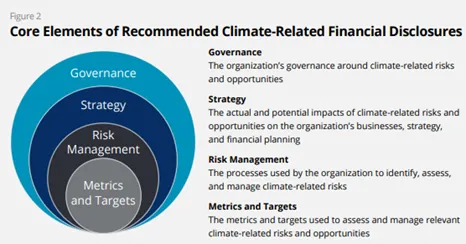Five Things to Know About TCFD
What is the Task Force on Climate-Related Financial Disclosures?
The Task Force on Climate-Related Financial Disclosures (TCFD) was created by the Financial Stability Board (FSB) in 2015 to develop consistent climate-related financial risk disclosures for companies, banks, and investors. In 2017, the TCFD released climate-related financial disclosure recommendations designed to help companies provide better information to support informed capital allocation. Its focus is to report on the impact an organization has on the global climate, as well as potential climate risks that the company will face, and seeks to make firms’ climate-related disclosures more consistent and comparable. With more informed data, companies can incorporate climate-related risks and opportunities into their risk management, strategic planning, and decision-making processes.
The TCFD structured its four overarching recommendations to represent core elements of how organizations operate: governance, strategy, risk management, and metrics and targets. These four overarching recommendations are supported by eleven recommended disclosures that build out the TCFD framework with information to help investors understand how reporting organizations assess climate-related risks and opportunities.
Source: TCFD’s Core Recommendations

What are the highlighted risks?
One of the main goals of the TCFD framework is to effectively evaluate climate-related risks to a company and its suppliers and competitors. The TCFD breaks down these risks into two categories: risks related to the physical impacts of climate change and risks related to the transition to a low carbon economy.
Physical risks and their associated impacts are divided into two types: acute physical risk and chronic physical risk.
- Acute risks are linked to extreme weather such as hurricanes, flooding, wildfire, drought, and heat waves, which can cause both direct damage to assets and indirect impacts from supply chain disruptions.
- Chronic physical risk, on the other hand, refers to long-term changes in climate and weather patterns, including sustained higher temperatures that can cause sea level rise and heat waves. These risks may affect organizations’ operations, supply chain, transportation needs, and employee safety due to changes in temperature, water availability, sourcing, quality, and food security.
To assess transition risk, companies must evaluate how socio-economic fluctuations resulting from society’s response to climate change could impact their business.
Transition risk includes policy, legal, and market risks, in which companies are subject to regulatory developments related to climate change and energy-specific regulations globally, such as regulation of greenhouse gas (GHG) emissions, carbon pricing, energy and fuel costs, and energy policy.
Businesses could also be subject to reputational risks as climate change moves up the consumer and investor agenda if they are not contributing to climate change mitigation. Examples include establishing corporate climate action plans and decarbonizing supply chains.
Who is required to follow TCFD?
As of 2021, there are 8 jurisdictions with TCFD-aligned official reporting requirements, including the UK, EU, New Zealand, Hong Kong, Japan, Switzerland, Brazil, and Malaysia. As of April 2022, it is mandatory for any company in the United Kingdom with over 500 employees and over £500 million in turnover to report climate-related financial data in line with TCFD recommendations. The upcoming International Sustainability Standards Board (ISSB), established at COP26 and expected to form a comprehensive global baseline of sustainability disclosures, incorporates and builds upon the TCFD for its climate disclosures.
While TCFD reporting remains optional in the United States, in May 2022, the U.S. Securities and Exchange Commission (SEC) proposed amendments to rules and reporting forms to promote consistent, comparable, and reliable information for investors concerning funds’ and advisers’ incorporation of ESG factors. The SEC's proposal requires qualitative disclosures according to TCFD recommendations and quantitative disclosures, involving emissions data according to the Greenhouse Gas Protocol. With the inclusion of TCFD recommendations in the SEC’s proposal, firms that are already adhering to TCFD will likely be positioned to meet new regulatory demands coming out of the SEC.
What are the benefits of TCFD reporting?
Companies may disclose TCFD recommendations as a means of providing transparency about their climate-related risk exposures to investors, lenders, and insurance underwriters. However, there are many more reported benefits of disclosing TCFD recommendations.
Companies reporting on TCFD recommended disclosures have experienced the following:1
- More informed strategic planning
- Increased awareness and therefore better risk management
- Easier or better access to capital by increasing investors and lenders’ confidence
- Enhanced response to existing disclosure requirements
- Reduced climate-related information requests from investors
What are the costs of TCFD reporting?
Despite these benefits, challenges related to preparing climate-related disclosures remain. Some of the most common challenges and costs companies face when adopting TCFD recommendations include:
- The time and financial costs related to gathering accurate and relevant data: TCFD has seen the greatest pushback regarding the reporting on Scope 3 emissions data due to the difficult nature of gathering, calculating, and reporting on indirect emissions that occur both in supply chains and employee commuting.
- The effort and time associated with climate scenario analysis: Conducting climate scenario analysis is challenging due to the complexity of the modeling associated with comprehensive climate scenario analysis. This includes assessing the materiality of climate-related risks, such as market and technology shifts, and physical risks, amongst others, that may uniquely impact business operations. There is also difficulty in defining scenarios that are relevant to a business and determining the related financial impacts and managerial responses to oversee these risks.
- The risks associated with documentation: Regulators, investors, and consumers may reject “green” claims and statements if TCFD or ESG reports are perceived to be inaccurate or exaggerated.
The TCFD-aligned reporting involves the challenging tasks of obtaining and reporting on scope 3 emissions and climate scenario analysis data, which requires companies to devote a substantial amount of time and resources. Companies may also experience the costs of reporting after publishing TCFD-aligned disclosures, as regulators or jurisdictions set out to find gaps in reporting or deem emissions reduction targets to be deceptive.
How we can help
Our ESG Advisory Services provides a range of services to support our clients in preparing TCFD-aligned disclosures. Contact us if you would like to talk through our perspectives on ESG disclosures and reporting or what it means to be a TCFD supporter.
1 TCFD survey results conducted by Accounting For Sustainability


